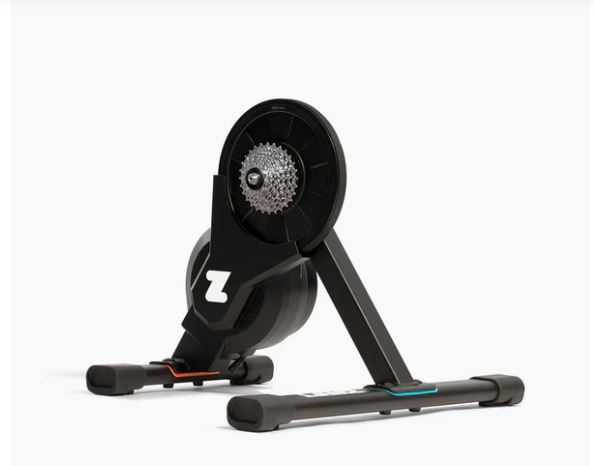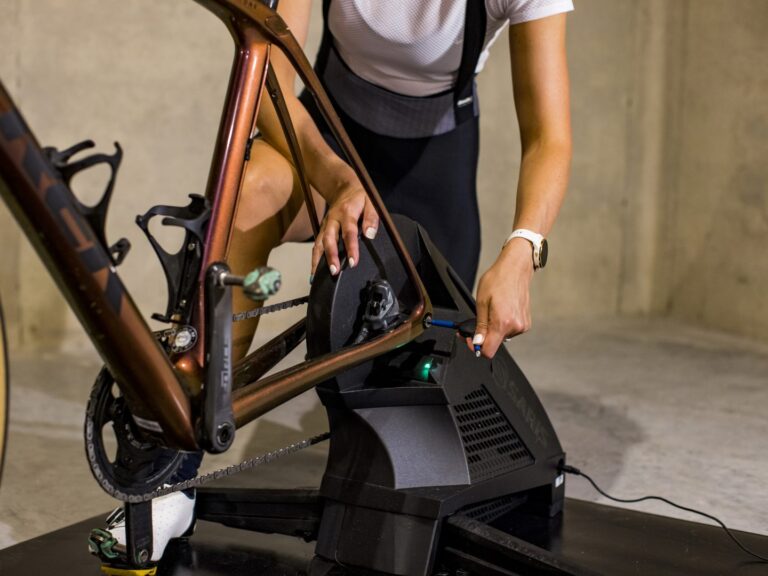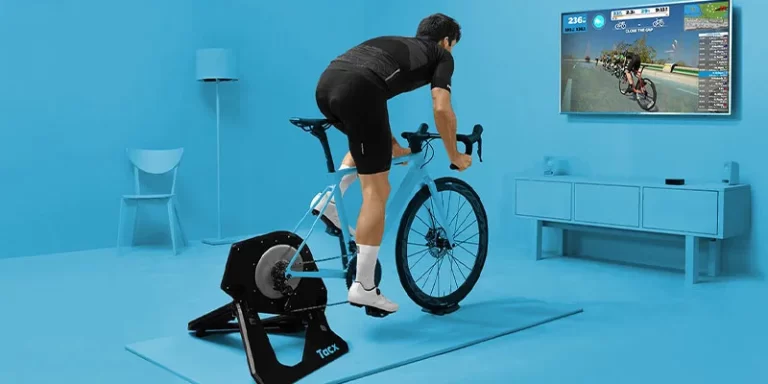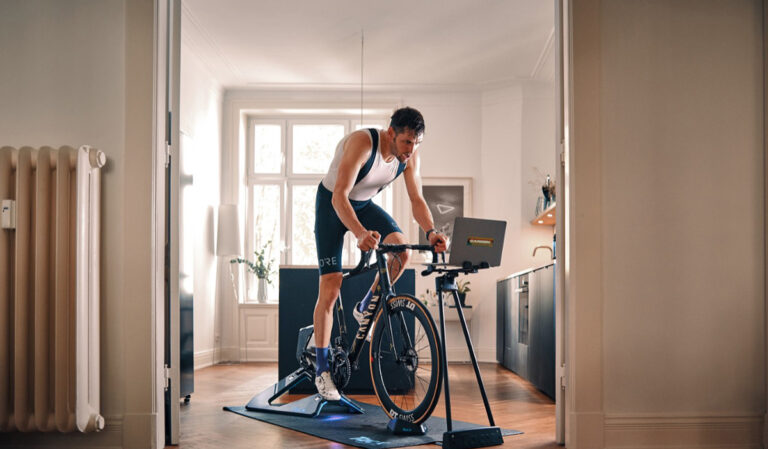Choosing the Right Type of Indoor Bike Trainer: A Masters Cyclist’s Guide

Key Point Summary of Choosing the Right Type of Indoor Bike Trainer:
- Types of Indoor Bike Trainers: Understand the difference between direct drive, wheel-on, magnetic, and fluid trainers.
- Direct Drive Trainers: Offer precise power measurement and a realistic ride feel but at a higher cost.
- Wheel-On Trainers: Provide convenience and portability, suitable for beginners.
- Magnetic and Fluid Trainers: Offer varying resistance levels, with fluid trainers known for their quiet operation and progressive resistance.
Throughout my years of racing on rugged mountain trails, sprinting across gravel roads, and hurdling barriers in cyclocross competitions, one constant has been the indispensable role of indoor training. Whether it’s braving the off-season or squeezing in a workout amidst a hectic schedule, my indoor bike trainer has been a steadfast ally.
For cyclists venturing into the world of indoor training, selecting the right type of bike trainer can be pivotal to your training experience and progress. Let’s delve into the various types of indoor bike trainers, each with its unique advantages and nuances.

The Road to Indoor Training
The transition to indoor training can be a bit of a culture shock for those of us accustomed to the unpredictable variables of outdoor cycling. My first encounter with an indoor trainer was a mix of curiosity and skepticism—could this device truly replicate the challenge and thrill of the open road? Over time, I’ve come to appreciate the controlled environment it offers, allowing for precise training sessions unaffected by weather or daylight.
Direct Drive Trainers
Direct drive trainers have revolutionized indoor cycling training with their accuracy and realism. By removing the rear wheel and attaching the bike directly to the trainer, they eliminate tire wear and slippage, providing a smooth and consistent ride. The direct drive system offers superior power measurement and a more realistic road feel, closely mimicking outdoor riding conditions.
My initial foray into direct drive training was an eye-opener. The quiet operation and the detailed performance feedback transformed my indoor sessions, making them more engaging and effective. However, the higher price point and the additional space required are considerations for potential users.

Wheel-On Trainers
Wheel-on trainers are the traditional choice for indoor cycling, offering ease of use and compatibility with a wide range of bikes. These trainers work by clamping onto the rear axle and pressing a roller against the rear tire to generate resistance.
One particularly memorable session involved a wheel-on trainer that I borrowed from a friend. Its simplicity and portability were standout features, allowing me to quickly set up and start training. While the tire wear and occasional noise were minor drawbacks, the accessibility of wheel-on trainers makes them a great entry point into indoor training.
Magnetic vs. Fluid Trainers
Magnetic and fluid trainers are two common types of resistance mechanisms found in indoor trainers. Magnetic trainers use magnets to create resistance, allowing for adjustable levels through a handlebar-mounted control or an app. They offer a reliable resistance option but can be louder and offer a less road-like feel compared to fluid trainers.
Fluid trainers, on the other hand, use a propeller within a fluid-filled chamber to create resistance. As your speed increases, so does the resistance, closely simulating the experience of riding on the road. My experience with fluid trainers has been notably serene; the whisper-quiet operation and progressive resistance make long sessions more bearable and realistic.
Making the Choice
Choosing the right indoor bike trainer depends on your cycling goals, budget, and the importance of ride feel and feedback. Direct drive trainers are ideal for serious cyclists focused on precise training and performance improvement. Wheel-on trainers suit those seeking convenience and simplicity. For a balance between realism and quiet operation, fluid trainers are an excellent choice, while magnetic trainers offer flexibility with adjustable resistance.

Wrapping Up
Indoor training has become an integral part of my cycling regimen, allowing me to maintain and improve performance year-round. The evolution of indoor bike trainers from simple, noisy devices to sophisticated, immersive training platforms has been remarkable. Whether you’re a seasoned racer or a beginner looking to stay fit, the right indoor bike trainer can transform your training, providing the consistency and challenge needed to reach your cycling goals. As you embark on your indoor training journey, consider your priorities and choose a trainer that aligns with your cycling aspirations and lifestyle.
Here are my top three picks for indoor bike trainers, reflecting a range of types and price points, suitable for cyclists from beginner to advanced levels:
- Wahoo KICKR Direct Drive Smart Trainer: The Wahoo KICKR is a top choice for serious cyclists seeking precision and a realistic riding experience. This direct drive trainer is renowned for its accuracy, stability, and compatibility with a wide range of training apps. It offers a realistic road feel, quiet operation, and powerful resistance capabilities, making it ideal for intense training sessions and virtual races. The KICKR also features automatic resistance adjustments to simulate real-world terrain changes.
- Garmin Tacx Neo 2T Smart Trainer: The Tacx Neo 2T stands out for its exceptional realism and advanced features, including road surface simulation, dynamic inertia, and direct drive design for near-silent operation. It’s one of the most accurate trainers on the market, providing detailed feedback on performance. The Neo 2T also offers wireless connectivity to a wide range of devices and apps, making it a versatile option for cyclists looking to enhance their indoor training experience with virtual routes and structured workouts.
- Saris Fluid2 Trainer: For those seeking a reliable, mid-priced option, the Saris Fluid2 offers excellent value. This fluid resistance trainer is known for its quiet operation and progressive resistance that scales with your speed, closely mimicking the feel of riding on the road. It’s easy to set up and compatible with a wide range of bicycles, making it a great choice for beginners and intermediate cyclists looking to boost their training without breaking the bank.
These trainers represent the spectrum of what’s available in terms of technology, realism, and price, catering to a wide range of cycling training needs and preferences. Whether you’re gearing up for race season or looking to stay fit during the off-season, investing in a quality indoor bike trainer can transform your training routine and help you achieve your cycling goals.

FAQ
How to choose an indoor bike trainer?
Consider your goals (e.g., fitness, race training), budget, space, noise level, and desired features (like smart connectivity for virtual training apps). Decide between direct drive for accuracy and quietness, or wheel-on for convenience and cost-effectiveness. Look for compatibility with your bike and preferred training software.
Do indoor bike trainers fit all bikes?
Most indoor bike trainers are designed to fit a wide range of bikes, including road, mountain, and hybrid bikes. However, compatibility can vary, especially with non-standard frames, thru-axles, or disc brakes. Adaptors are available for most trainers to fit different axle standards.
Does it matter what bike you put on a smart trainer?
While most bikes can be used with a smart trainer, the choice of bike can affect your training experience. A bike in good working order and one that closely matches your outdoor bike in terms of geometry and setup can provide a more realistic and beneficial training session.
What are the different types of bike trainers?
- Direct Drive Trainers: Replace the bike’s rear wheel, providing a quiet, realistic ride feel and accurate power measurement.
- Wheel-On Trainers: Apply resistance to the bike’s rear tire. They are more affordable but can be noisier and less accurate.
- Magnetic Trainers: Use magnetic fields to create resistance. They are adjustable and relatively quiet.
- Fluid Trainers: Use a fluid chamber for resistance, known for their progressive resistance and quiet operation.





